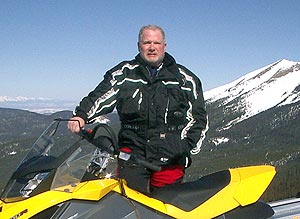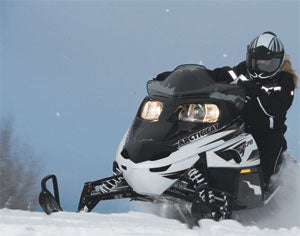Bassett’s Blog: Scary Times Ahead?

Cat faces declines as snow needed to boost sales
Arctic Cat faced with tougher than anticipated times ahead? That’s what you can read into the latest quarterly reports. Sled sales for the quarter were down. ATV sales were down. Overall sales were down.
Traded in the US stock market as ACAT, Arctic Cat reported net sales of US$205.2 million for the fiscal 2008-second quarter ended Sept. 30, 2007. This compares to US$285.3 million in the same period last year, a drop of 28 per cent.
Looking at the picture for the first half-year, net sales were US$293.1 million compared with US$381.7 million in the first six months of last fiscal year. That’s a 23% decline year-to-year. And the previous year was not a great one.

 With ATVs accounting for Cat’s largest percentage of revenues. The company pins high hopes for success on its new 1000cc Thundercat model.
With ATVs accounting for Cat’s largest percentage of revenues. The company pins high hopes for success on its new 1000cc Thundercat model.
Lack of Snow
As we look at the numbers, it is obvious that the decline in sled sales is primarily due to lack of snowfall, thus a drop in eager consumerism to buy replacement or new snowmobiles. Arctic Cat previously announced an aggressive reduction in its snowmobile production to help reduce inventory at its dealer levels. As Cat’s president Chris Twomey acknowledges, “Arctic Cat has taken this action because a lack of snowfall for 10 consecutive years in various regions of North America has led to lower industry wide, retail snowmobile sales and slightly higher dealer inventories.” We accept that. The dearth of snow hinders sales for all snowmobile manufacturers. Virtually all sled makers are working to reduce previous years’ inventory at their dealers to make way for newer models, but there is another problem, at least in the US. ‘Fun’ Money Scarce At the annual shareholders meeting held this past summer in Thief River Falls, Twomey suggested that a growing lack of discretionary ‘fun’ money due to people’s loss of home equity might make some consumers leery of buying a new sled or ATV. He sees this as a bigger issue than rising gasoline prices. He feels that as long as fuel is available, people will be willing to pay to enjoy powersports. He noted that Canadians have had fuel prices above $3 per gallon for some time and that sales of Arctic Cat snowmobiles (where there had been snow) were up slightly more than 18% in Canada. While Twomey is adamant that snow drives sled sales, he says that Cat would reinforce its message of innovation and be creative in offering greater value to stimulate sales.
Decline in Sled Sales
He readily acknowledges that there has been almost a 50% decline in sled sales in the past 10 years. Last season, all sled makers sold slightly more than 160,000 units. Compare that to 1997’s sales of not quite 261,000 sleds worldwide. Sled sales haven’t been below 160,000 units since 1993, when they hit 158,000. The lowest recorded unit sales came in 1968 when industry figures show 85,000 units sold. Of course, 255,000 units were sold the next season in 1969 and peaked at almost 500,000 units two years later in 1971.
ATV Sales
We didn’t expect great things in sleds, but we are somewhat concerned about what’s going on in ATV sales. To this point, Cat had been riding an upward curve with its Arctic Cat ATV line. That trend was opposite the ATV industry, which has seen declines as the ATV market matures and demand slows. Still, the advent of side-by-side UTV models like Cat’s Prowler helped make up for lost four-wheeler sales. That seems to be weakening as Arctic Cat reported ATV sales of US$77.5 million in the 2008-second quarter, versus US$133.8 million in the same period last year. That’s a 42% decline for year-to-year ATV sales.
Cat officials reported that previously announced lower production levels and a shift in ATV shipments to future quarters when the company’s new models will be available impacted ATV sales.
“Although we’ve adjusted our ATV production schedule to realistically reflect the current market, we continued to see strong interest in several of our innovative, new ATV models,” says Twomey.
Other Companies
Another company expecting a sales boost is ATV segment leader Honda, which claims for fiscal 2007 that it is targeting North American sales of 650,000 units for motorcycles, ATVs and PWC—an increase of 5.7 per cent.
Polaris reported earlier that it was telling investors and analysts that it was raising its full-year 2007 guidance for income from continuing operations. Polaris based its revised outlook on its belief that the fast-selling Ranger RZR side-by-side model will lead an increase in ATV sales. Cutting production like Arctic Cat to relieve dealer inventory of snowmobiles, Polaris’ claimed its snowmobile sales were up 5 per cent. Polaris’ Victory motorcycle sales were down 17% in the most recent quarter, this despite introduction of a totally new touring model, the Victory Vision.
Snow Equals Sales?
Bottom-lining these facts is one simple conclusion: times are challenging in the powersports business right now. While US snowmobile consumers are leery, Cat’s Twomey claims that surveys of snowmobilers show very few are ready to abandon the sport, they are waiting for snow. As a Yamaha spokesman told Snowmobile.com, consumers need to use up their current sleds first before they are ready to buy new. It’ll take snow to do that. And Yamaha is excited about the opportunity, because it claims that its surveys show that more than half of all snowmobilers would consider a four-stroke sled. Since Yamaha is all four-strokes, that leaves the other three snowmobile manufacturers to fight over the remaining half of potential customers.
As Cat shows in its latest earnings report, it can be all good if it snows—not so much, if it doesn’t.






 Your Privacy Choices
Your Privacy Choices